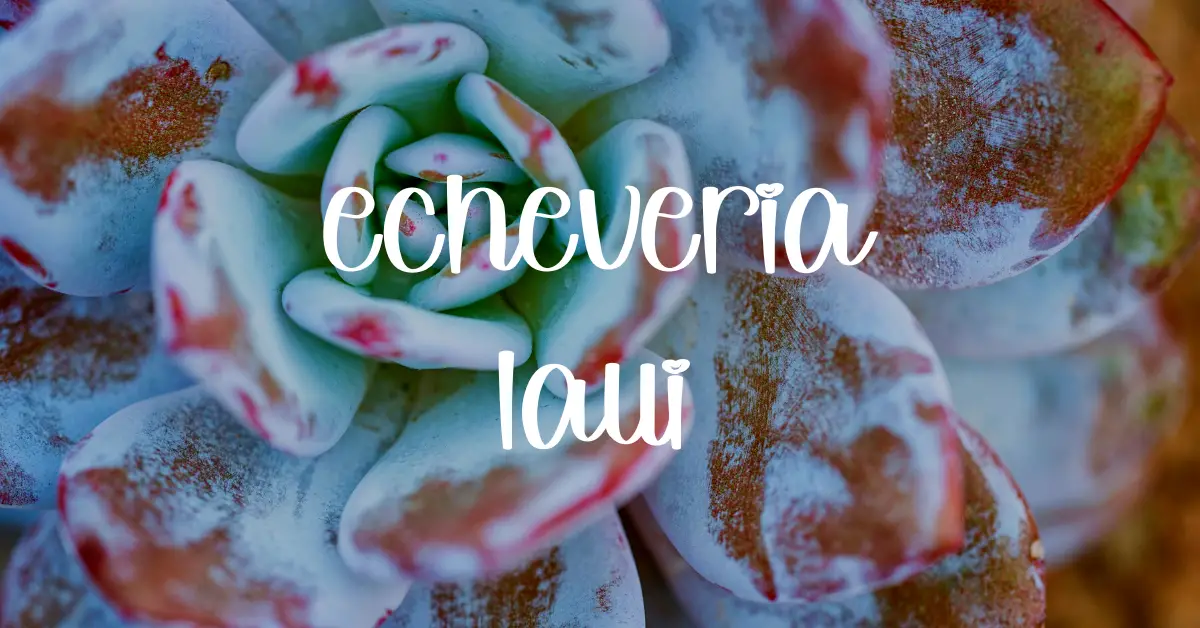
Echeveria laui is a species of flowering succulent plant native to Mexico. It is a member of the Crassulaceae family, which includes a wide variety of popular succulent plants such as jade plants, stonecrops, and sedums. Echeveria laui is known for its attractive rosette shape and distinctive blue-gray leaves, which give it a unique appearance.
Description
Echeveria laui grows in a rosette shape, with leaves radiating out from a central point. The leaves are thick and fleshy, and have a blue-gray color with a powdery coating that gives them a silver or gray appearance. The plant grows slowly, and typically reaches a height of about 8 inches (20 cm) and a width of about 12 inches (30 cm). Echeveria laui produces small, pink or orange flowers that bloom on tall stalks. The flowers are usually about 1 inch (2.5 cm) in diameter and are held on stalks that can reach a height of up to 18 inches (45 cm).
Habitat and Care
Echeveria laui is native to Mexico, where it grows on rocky cliffs and slopes. In its native habitat, it is exposed to plenty of sunlight and grows in well-draining soil. When grown as a houseplant, Echeveria laui should be placed in a location with plenty of indirect sunlight. It will tolerate some shade, but it is important to give it enough light to maintain its attractive blue-gray color.
Echeveria laui is sensitive to overwatering, so it is important to be careful not to water the plant too frequently. The soil should be allowed to dry out completely between waterings, and the plant should be watered deeply but infrequently. Echeveria laui is not particularly sensitive to temperature, and it can be grown indoors or outdoors in a wide range of temperatures.
Propagation
Echeveria laui can be propagated by dividing the offsets that form around the base of the plant, or by taking stem cuttings. To divide offsets, gently separate them from the main plant and plant them in well-draining soil. The offsets can be planted in pots or in the ground, depending on the desired location. To take stem cuttings, cut a healthy stem from the plant and remove the lower leaves. Place the cutting in a rooting hormone, then plant it in well-draining soil. Keep the soil moist but not waterlogged, and the cutting should root within a few weeks.
Definitely check out: How to Water Succulents So They Don’t Die
Pests and Diseases
Echeveria laui is generally resistant to pests, but it can be prone to mealybugs and aphids. These pests can be controlled by removing them by hand or using an insecticide. Echeveria laui can also be prone to rot if it is overwatered or if the soil does not drain well. To prevent rot, it is important to water the plant carefully and make sure the soil drains well.
You might like: My Succulent Leaves Are Turning Yellow
Conclusion
Echeveria laui is a beautiful and easy-to-care-for plant that is well-suited for growing as a houseplant. With proper care, Echeveria laui will thrive and produce attractive flowers. Its attractive rosette shape and distinctive blue-gray leaves make it a standout addition to any collection of succulent plants. Whether you are a seasoned plant collector or just starting out, Echeveria laui is a great choice.
Quick question: Should you mist succulents? Find that answer here.

Growing Season:
Summer
Dormant Season:
Winter
- Hardy to USDA Zone: 10a
- Size: Up to 12″ wide
- Foliage: Densely covered in powdery farina. The leaves underneath the glaucous coating are actually reddish.
- Flower: Peach
- Propagation: Stem cuttings, leaves, seed
- Light: Full sun, bright shade
- Water: Drench & Dry very carefully
- Soil: Gritty, mostly inorganic, quickly draining
- Origin: Oaxaca, Mexico
About Echeveria laui
Echeveria laui is new to my collection as of August 2020. I’ve lusted over it for quite a while now, but had been reluctant to buy one because they were pricy, notoriously hard to care for and not available locally. Two of those things changed and they entered into my price range and local growers started selling their stock. I wanted to find one as unblemished as possible. The thick, powdery coating of farina on the Echeveria laui leaves is so very easily damaged by even a light touch.
Try not to get water on the leaves of your Echeveria laui as even water will damage the coating. Use a squirt bottle with a narrow tip to make sure you water the soil thoroughly when it is time. Be sure to follow the guide to watering succulents here.
Echeveria laui is mostly solitary which means it doesn’t really produce offsets like other species. It does propagate by leaf or stem cutting though.
Damage to the farinose coating on the leaves WILL happen during shipping. There’s really no way around it. The challenge for succulent collectors is to not touch the leaves at all once it is settled in its pot. E






